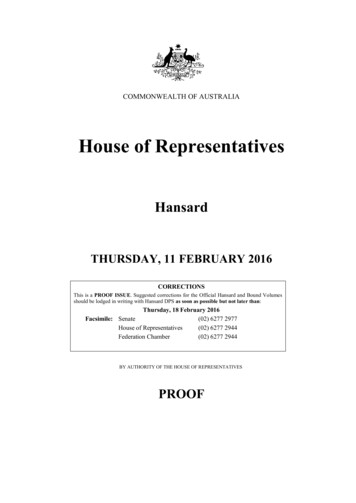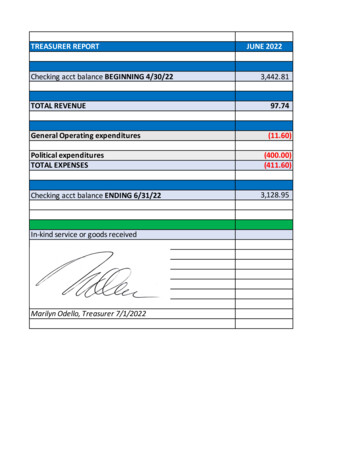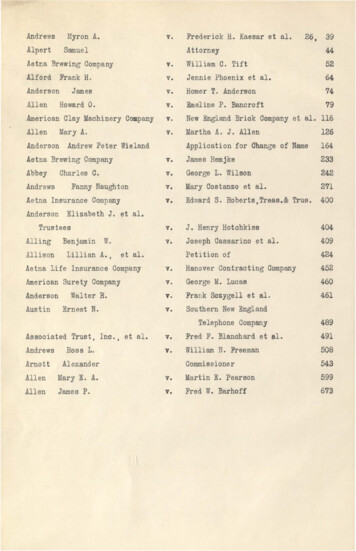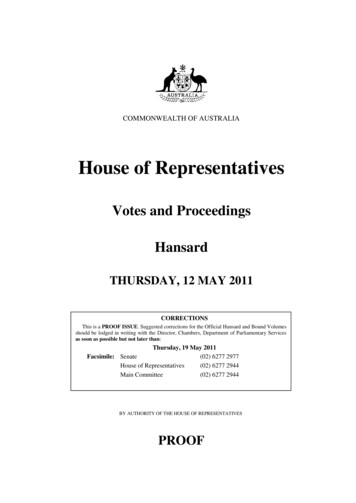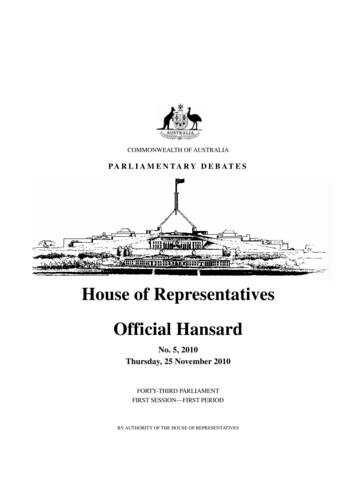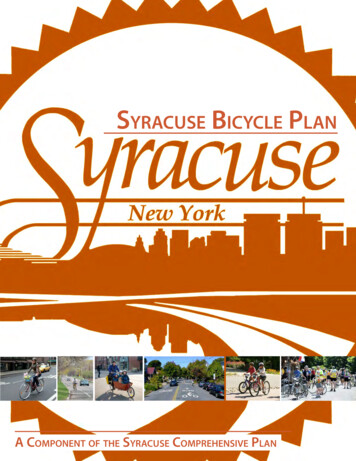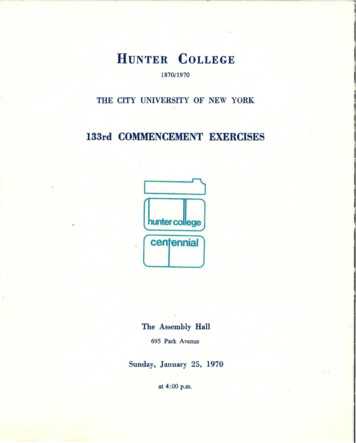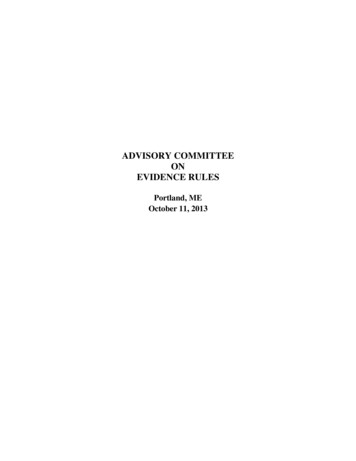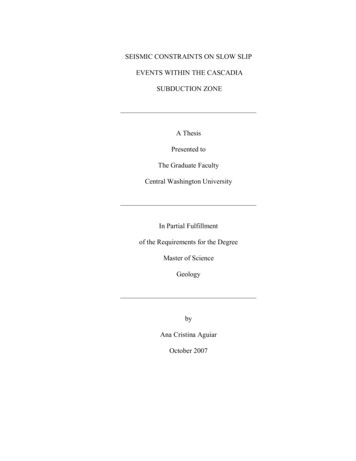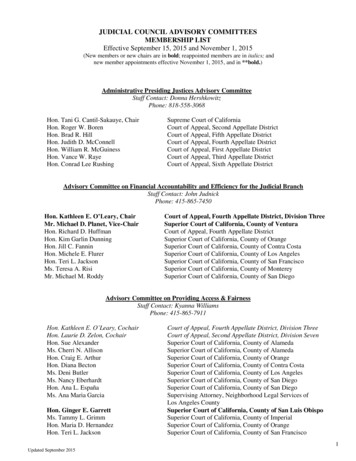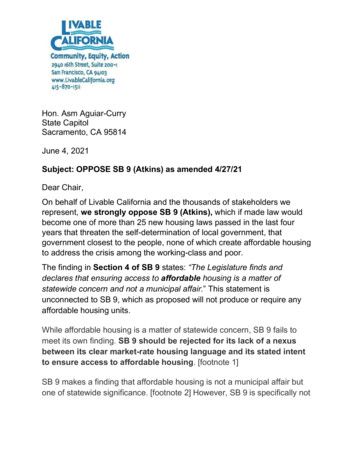
Transcription
Hon. Asm Aguiar-CurryState CapitolSacramento, CA 95814June 4, 2021Subject: OPPOSE SB 9 (Atkins) as amended 4/27/21Dear Chair,On behalf of Livable California and the thousands of stakeholders werepresent, we strongly oppose SB 9 (Atkins), which if made law wouldbecome one of more than 25 new housing laws passed in the last fouryears that threaten the self-determination of local government, thatgovernment closest to the people, none of which create affordable housingto address the crisis among the working-class and poor.The finding in Section 4 of SB 9 states: “The Legislature finds anddeclares that ensuring access to affordable housing is a matter ofstatewide concern and not a municipal affair.” This statement isunconnected to SB 9, which as proposed will not produce or require anyaffordable housing units.While affordable housing is a matter of statewide concern, SB 9 fails tomeet its own finding. SB 9 should be rejected for its lack of a nexusbetween its clear market-rate housing language and its stated intentto ensure access to affordable housing. [footnote 1]SB 9 makes a finding that affordable housing is not a municipal affair butone of statewide significance. [footnote 2] However, SB 9 is specifically not
structured to address affordable housing: the bill places no limitations onrental or sales price of units constructed through its implementation.The only clear result of SB 9’s reference to our affordable housingemergency is its waiver of any requirement to consider the environmentalconsequences of quadrupling the density on 56% of all residential parcelsin California, totaling about 7 single-family million lots.Some visible proponents of SB 9 have exaggerated California’s crisis as a3.5 million unit housing shortage. Freddie Mac clearly attempts to correctthis urban myth in its 2021 report: the U.S., as a whole has, a shortage of3.3 million units. California has a 1.2 million unit shortage [footnote 3]. And960,000 units are needed specifically for poor and low-income households,not for SB 9 households paying market-rate prices. [footnote 4].We ask that you reject SB 9 for these reasons:1. SB 9 will add to the cost of development because each parcel willbecome eligible for 2-to-4 times the density now permitted, allowing 4units where one used to be. However, because there is no languagein SB 9 that excludes ADUs, the density may go to 6 units. [footnote5]. The bill language remains vague on the key issue of how manyunits may be created on a single family lot. Our experts read it toallow 6 units . The state will be burdened with the cost oflawsuits to resolve this divisive issue.2. The density mandated will result in a severe cost burden to localjurisdictions for supporting infrastructure. SB 9 does not allowCEQA review to define the impact burdens. Instead of resulting incommunity investment, improvement, and infrastructurereconstruction, it offloads all costs related to quadrupled density ontoaffected communities that cannot afford the costs. This will degradeCalifornia on a broad scale. The bill for firefighting, flooding,new freeway exits and new freeway bridges are state costs.3. SB 9 is a market-driven bill to the primary benefit of privatedevelopers. By up-zoning 7 million parcels throughout the state andredefining “highest and best use," California will significantly increase
4. land value beneath single-family zones, as Vancouver has verifiedfollowing its own mass upzoning, placing home ownershipfurther out of reach of first-time homebuyers.5. SB 9 maximizes the development of high-end market-ratehousing without addressing the crisis of housing affordability.Of the 830,000 housing-unit shortage in California, identified innew 2021 research from Freddie Mac, the Freddie Mac partnerNational Low Income Housing Coalition found that most of the unbuiltunits are needed for low-income households.6. SB 9 will promote gentrification in stable neighborhoods,especially neighborhoods of color, the naturally occurring targets forspeculators. Speculators will seek these area’s cheaper parcels inseeking higher profits, turning stable Black and Latino neighborhoodsinto targets for speculators/investors to buy up and turn homes intohigh-cost rentals without garages or yards. It will reduce the abilityof people of color to build generational wealth.7. SB 9 is the wrong solution to the wrong problem. We don’t have amarket-rate housing crisis. We have a housing affordability crisis,that will only be made worse by SB 9. SB 9 and its companion billswould apply the failed theories of trickle-down economics toCalifornia’s housing affordability crisis.8. Below are scores of groups opposing SB 9, including antihomelessness organizations, Latino and Black coalitions, numerouscities and neighborhood organizations. Adams Hill Neighborhood AssociationAids Healthcare FoundationAlameda Citizens Task ForceAlbany Neighbors UnitedBerkeley Associated Neighbors Against Non-affordable HousingBrentwood Homeowners AssociationBurton Valley Neighborhoods GroupCalifornia Alliance of Local ElectedsCalifornia Cities for Local ControlCalifornia Contract Cities AssociationCatalysts
Cities of Arcata, Azusa, Bellflower, Belmont, Beverly Hills, Brea,Brentwood, Burbank, Camarillo, Carpinteria, Carson, Cerritos,Chino, Chino Hills, Clayton, Clearlake, Clovis, Colton, Corona,Cupertino, Cypress, Diamond Bar, Dorris, Downey, Dublin,Eastvale, El Segundo, Escalon, Fortuna, Foster City, FountainValley, Garden Grove, Glendora, Grand Terrace, Half MoonBay, Hesperia, Hidden Hills, Huntington Beach, Indian Wells,Inglewood, Irvine, Irwindale, Kerman, King, La CanadaFlintridge, La Mirada, La Palma, La Quinta, La Verne, Lafayette,Laguna Beach, Laguna Niguel, Lakeport, Lakewood, Lancaster,Lomita, Los Alamitos, Los Altos, Martinez, Maywood, Menifee,Merced, Mission Viejo, Montclair, Monterey, Moorpark, Murrieta,Newman, Newport Beach, Norwalk, Novato, Oakdale, Ontario,Orinda, Palo Alto, Palos Verdes Estates, Paramount, Pasadena,Pinole, Pismo Beach, Placentia, Pleasanton, Poway, RanchoCucamonga, Rancho Palos Verdes, Rancho Santa Margarita,Redding, Redondo Beach, Rohnert Park, Rolling Hills, RollingHills Estates, San Carlos, San Clemente, San Dimas, SanGabriel, San Jacinto, San Marcos, San Marino, Santa Clara,Santa Clarita, Santa Monica, Saratoga, Signal Hill, SouthPasadena, Stanton, Sunnyvale, Temecula, Thousand Oaks,Torrance, Tracy, Vacaville, Ventura, Vista, Westlake Village,Whittier, and Yorba Linda Citizens Preserving Venice Coalition for San Francisco Neighborhoods Coalition to Save Ocean Beach College Street Neighborhood Group College Terrace Residents Association Committee to Save the Hollywoodland Specific Plan Community Associations Institute - California Legislative ActionCommittee Comstock Hills Homeowners Association D4ward Durand Ridge United Encinitas Neighbors Coalition Friends of Sutro Park Hidden Hill Community Association Hills 2000 Friends of The Hills Hollywood Knolls Community Club Hollywoodland Homeowners Association Howard Jarvis Taxpayers Association Kensington Property Owners Association La Brea Hancock Homeowners Association
Lafayette Homeowners CouncilLakewood Village Neighborhood AssociationLas Virgenes-Malibu Council of GovernmentsLatino Alliance for Community EngagementLeague of California CitiesLeague of California Cities Central Valley DivisionLinda Vista-Annandale AssociationLivable CaliforniaLivable PasadenaLos Altos ResidentsLos Angeles County Division, League of California CitiesLos Feliz Improvement AssociationMarin County Council of Mayors and CouncilmembersMiracle Mile Residential AssociationMiraloma Park Improvement ClubMission Street NeighborsMontecito AssociationNeighborhood Council Sustainability Alliance Trees CommitteeNorth of Montana AssociationNortheast Neighbors of Santa MonicaPacific Palisades Community CouncilPlanning Association for The RichmondRiviera Homeowners AssociationSan Gabriel Valley Council of Governments (UNREG)Save LafayetteSeaside Neighborhood AssociationShadow Hills Property Owners AssociationSherman Oaks Homeowners AssociationSouth Bay Cities Council of GovernmentsSouth Bay Residents for Responsible DevelopmentSouth Shores Community AssociationSouthwood Homeowners AssociationSunnyvale United NeighborsSunset-Parkside Education and Action CommitteeSustainable TamalmonteTahoe Donner AssociationTemecula Valley Neighborhood CoalitionTowns of Apple Valley, Colma, Fairfax, Mammoth Lakes, Ross,and Truckee United Neighbors Ventura Council of Governments
Verdugo Woodlands West Homeowners AssociationWest Pasadena Residents' AssociationWest Torrance Homeowners AssociationWest Wood Highlands Neighborhood AssociationWestside Regional Alliance of CouncilsWestwood Hills Property Owners AssociationWestwood Homeowners AssociationWilshire Montana Neighborhood CoalitionWindsor Square AssociationWe ask the Assembly to oppose SB 9’s flawed approach for the costsitwill add to the State and its negative impacts on communities.Should your Committee decide to support SB 9, it should make a findingthat the state is obligated to provide an undetermined level of funding tolocal governments to cover major financial consequences of this bad bill.Sincerely,The Board of Directors of Livable CaliforniaRick Hall, PresidentT Keith Gurnee, MemberCarey White, MemberIsaiah Madison, MemberFootnotes Below
Footnotes1. California Housing and Community DevelopmentDepartment further demonstrates on its own “dashboard”that housing identified in its statewide records (5th cycle)through 2019, over 100% of the housing target forabove-moderate income housing units were met; 41%of Moderate income targets met; 16.8% low incometargets met; and 11.3% very low income targets met. Inthe City of Los Angeles alone, developers built more than261% of its state-required above-moderate housingunits. San Francisco reached 158% of state targetsfor above -moderate income housing units. San Diegoreached 97.2% of its target for above-moderate-incomehousing units. Yet like most cities, the state’s DensityBonus laws are so ineffective that San Diego has fallenfar behind in attracting projects for moderate, low andvery low income households: just 0.2%, 15% and 11%,respectively, of the affordable units that city needs.hcd.ca.gov/app.powerbigov.usThe Embarcadero Institute RHNA Analysis demonstratesthat California’s 58 counties are “far exceeding theirmarket rate housing targets, while failing far short on theiraffordable housing targets.” Yet 14 of the most populouscounties, together, have issued permits for about 300,000market rate housing units, when only 140,000 are neededor required by HCD. embardcaderoinstitute.com
2. Senate Bill 9 concludes with language directed ataffordable, not market-rate, housing:SEC. 4. The Legislature finds and declares that ensuringaccess to affordable housing is a matter of statewideconcern and not a municipal affair (emphasis added) asthat term is used in Section 5 of Article XI of the CaliforniaConstitution. Therefore, Sections 1 and 2 of this actadding Sections 65852.21 and 66411.7 to theGovernment Code and Section 3 of this act amendingSection 66452.6 of the Government Code apply to allcities, including charter cities.3. Freddie Mac freshly reports that the U.S. has a 3.3 millionhousing unit shortage, in severe contrast to YIMBY, andat times even legislators’ claims, that California alone hasa 3 or 3.5 million housing unit shortage. In fact ourshortage is about 1 imates-housingshortage-33-million-homes4. The National Low Income Housing Coalition verifies inthis extensive study that, specifically, California's shortageof housing for low-income households is 960,000units. https://reports.nlihc.org/gap5. In an April 27, 2021 amendment, SB 9 continues topermit JADU/ADU on the first lot created under itsprovisions. Any savvy builder can exploit this clear“Two-Step” loophole because the JADU/ADU limitationapplies only to the newly created lot (in this case, the 40%parcel created as a result of the ministerial lot split):(i) (1) Notwithstanding any provision of Section 65852.2,Section 65852.21, Section 65852.22, Section 65915, orthis section, a local agency shall not be required to permitmore than two units on a parcel created through theexercise of the authority contained within this
section.(2) For the purposes of this section, “unit” means anydwelling unit, including, but not limited to, a unit or unitscreated pursuant to Section 65852.21, a primary dwelling,an accessory dwelling unit as defined in Section 65852.2,or a junior accessory dwelling unit as defined in Section65852.22.Start with 1 R1-zoned, single family lot with or without1 home. Puts 2 new homes (if was vacant) or 1 newhome, on 60% of lot. Adds ADU and JADU. Four unitsnow on 60%. Split off 40% per urban lot split. Puts 2 unitsof any kind on 40% portion. Total equals six units.
We ask that you reject SB 9 for these reasons: 1. SB 9 will add to the cost of development because each parcel will become eligible for 2-to-4 times the density now permitted, allowing 4 units where one used to be. However, because there is no language in SB 9 that excludes ADUs, the density may go to 6 units. [footnote 5].
